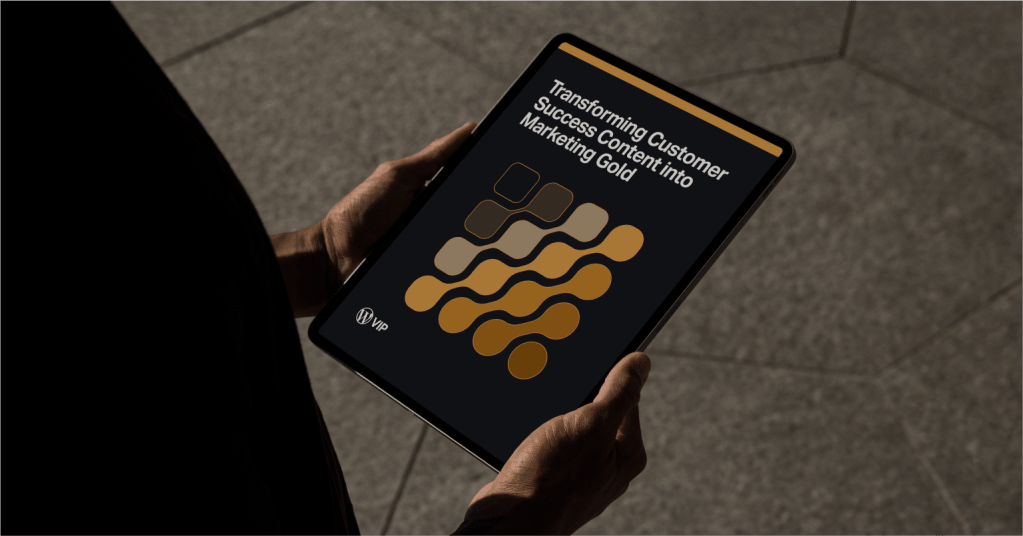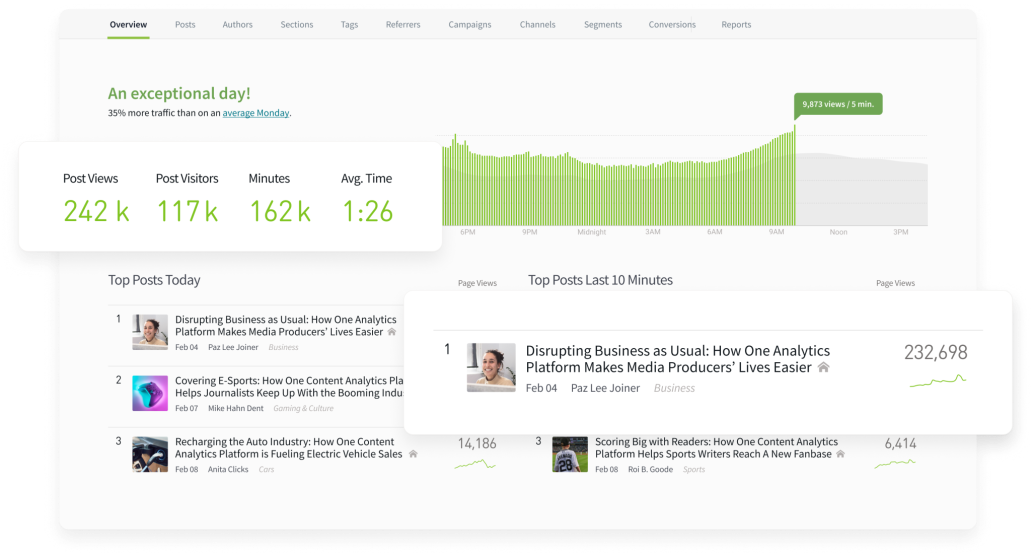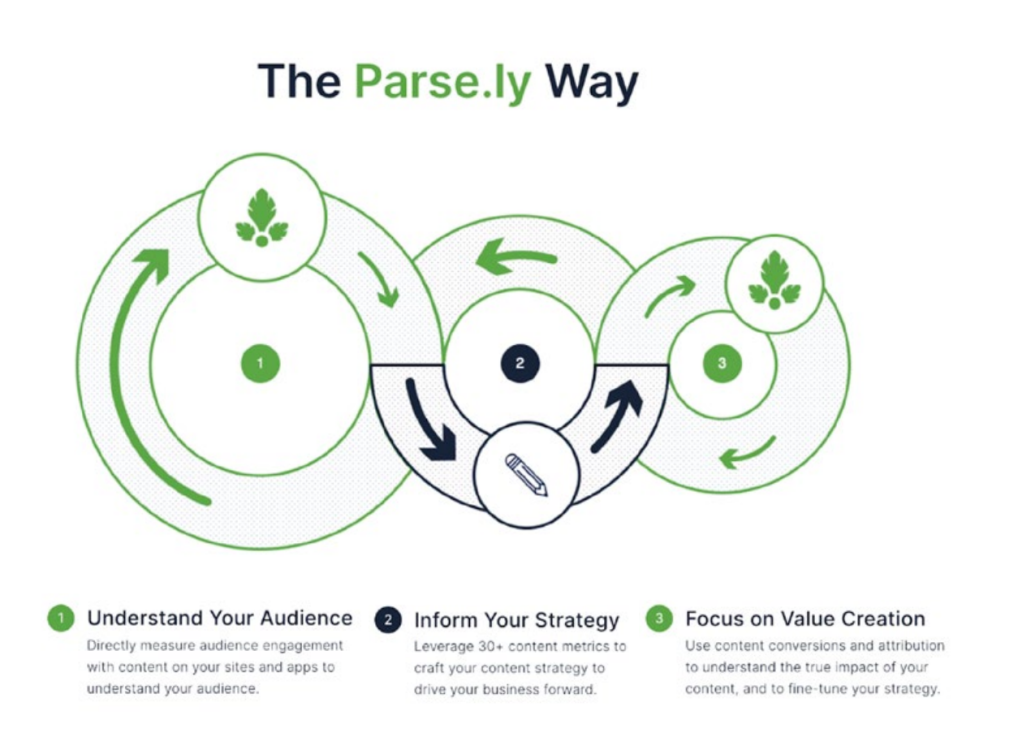How To Turn Customer Success Content to Gold

Fuel business growth with a cross-functional content strategy
Too often, Content Marketing and Customer Success teams work in silos. On the surface, it appears that each team is working toward different goals with different metrics, and often don’t overlap their strategies and communication.
That’s why tapping into cross-functional collaboration can yield excellent results for organizations with content at the core of interactions for both customers and prospects.
If you’re in a content marketing role, you may not have insight into the interactions your Customer Success team has with your customers. Likewise for those in a customer success role, understanding the kinds of content customers engage with—before they become customers—can enhance your understanding of their needs.
But, here’s the thing. These teams’ goals are actually remarkably similar. Both focus on helping prospects or customers get more value out of the tools they use, enabling them to be more successful in their roles.
Our goal is to inspire you to reach out to the other team and work together.
We’ll discuss actionable tips and tactics you can use to align both teams toward a unified mission: producing an exceptional customer experience that results in business growth.
Meet the team:
This is Customer Success Clara and Content Marketer Mark. You’ll see them exhibiting ideal bridge-building throughout this guide.

“Hi, I’m Mark.”
The value of customer success content in marketing
In one way or another, every role in a company should focus on improving the customer experience (CX). That leads to happier customers, which leads to business growth. But let’s zero in on Customer Success.
What is Customer Success?
At its heart, Customer Success empowers customers to get the most value out of your products and services. Typically, Customer Success onboards, consults with, trains, and supports your customers. Whatever their role, they are essential to a good CX.
Through the funnel—and beyond!
Both Customer Success and Content Marketing teams lead with a customer-centric mindset (or should). Both teams have goals and KPIs that contribute to overall organizational success. They differ in one key area: customer touch points.
Content marketing is essential throughout the stages of the marketing funnel, but once the prospect turns into a customer, it’s the Customer Success team’s responsibility to retain and expand that business. Expansion and retention are especially important during economic uncertainty, so building customer loyalty and advocacy through CX content is crucial.
The pain points of your customers are not inherently different from your prospects.
It’s easy to forget customers were prospects once. Your prospects and customers are not different personas, they’re just in different lifecycle stages. Both can benefit from marketing efforts that you may only think of as being beneficial to one or the other, such as technical documents for prospects or brand content for customers.
“Customer experience is the only source of sustainable competitive advantage.”
— Jary Carter, Chief Revenue Officer, WordPress VIP
Improving the CX is marketing, and marketing to prospects is part of their CX
That’s why it’s crucial for Customer Success and Content Marketing to work together.

“I set up a meeting for us on Thursday to talk strategy.”
3 ways Customer Success and Content Marketing can work together on the business growth journey
To eventually repurpose customer success content into marketing efforts, first establish concrete and symbiotic ways each team can benefit from the other.
1. Build roads and bridges between teams.
Relationship building is a fundamental aspect of making this arrangement work for both teams. Reach out to those on the other team, get to know them. What do they do? How do they work with customers? What are their strengths?
Establish and keep communication. This may involve a dedicated joint Slack channel, regular cross-functional meetings, occasional social gatherings, or all of the above. As you grow your relationships, you’ll leverage the strengths and knowledge of these individuals later on.
If you don’t already have a Customer Marketer role, it’s worth establishing one. Besides improving the customer experience, they offer the perfect resource to spearhead bridge-building between teams. They can structure collaborative goals, facilitate communication, relay key strategies and information, and keep both teams focused on the primary goal of improving the customer experience.
Cross-departmental communication fosters creativity and adds value to existing content

2. Align goals and metrics on your roadmap.
Customer Success and Content Marketing typically have metrics that look different on the surface. But these can be easily aligned into a common strategy.
Content marketers are often measured on demand generation— bringing in new business—and customer success professionals on new customer onboarding, product adoption, and account retention and expansion. But let’s look beyond these immediate goals.
Content marketers will bring in new business more easily if they deeply understand the needs of existing customers. Customer Success can use content to improve the customer’s perceived value of the product.
Finding aligned opportunities requires creative thinking, but it becomes easier the more you establish a relationship between teams.
3. Prepare for possible pitfalls.
When embarking on collaboration between Content Marketing and Customer Success, don’t be discouraged by pitfalls you encounter. With adequate preparation and planning, any potential roadblocks can be mitigated to ensure a smooth experience for team members, prospects, and customers.
- Use a consistent brand voice. Ensure both teams understand your brand voice. An in-house style guide is an essential reference, documenting not only company voice and tone, but basics like spellings, capitalizations, and other concerns relevant to your specific business. Having it all written down helps teams speak from a singular voice and perspective to provide a consistent customer experience.
- Know whom you’re speaking to. Create a document that outlines the key personas who interact with your brand. Ensure all teams understand these personas when communicating with them.
- Implement a review process. Have at least one team member from each team review communications and published content for consistent tone and quality.
- Share a centralized calendar. Assign a team member to “air traffic control,” coordinating outbound customer communication between teams, so customers aren’t bombarded.
You’ve got a strong cross-functional strategy, now what?
Once you feel that Customer Success and Content Marketing are working together toward common goals, identify customer success content that can be transformed into highly-effective marketing collateral.
How to turn customer success content into marketing campaigns
There are three main facets of transforming customer success content into new marketing collateral and campaigns.
- Identify optimal content
- Source new content
- Repurpose existing content
These actions can happen in any order and will likely overlap in many ways. The important thing to remember is to collaborate and communicate throughout.
Beware of friction
Any time you implement large changes or merge teams, expect some tension. That’s normal! Just make sure to implement change management and prioritize clear communication, welcome feedback, and provide guidance every step of the way to help reduce conflict.

1. Identify optimal customer success content to use in marketing collateral
The first way to recognize good marketing-focused customer success content requires you to dig into performance metrics to determine what resonates best with your audience.
Use data at every stop.
Becoming data-driven means more than just setting-and-forgetting analytics tools. It means constantly reviewing and measuring metrics and then optimizing your efforts based on those metrics.
With so many trackable metrics, it’s important to decide what questions you need your data to answer. Come up with those, and you’ll be able to benchmark the relevant metrics and decide what success looks like to you.
While Customer Success and Content Marketing will be tracking different metrics, there may be places to find synergies between teams. For example, you might use the traffic data between product documentation and your marketing site to optimize the customer journey. Or use recirculation rate and conversion data between content targeted at prospects and customers to make better decisions about which content converts. Whichever success metrics you land on, use that data to prioritize what you work on together.
“I primarily got Parse.ly for the editorial team because storytelling is our bread and butter, and we need to be able to… prove our worth, but also learn and grow in our work.”
— Michael Kress, Editor in Chief, Teach For America
Note: everything on your site is content, including technical references and documentation. If your user guides and technical how-to’s are performing the best, even with search engines, don’t discount the importance those may have to prospects, too. If you haven’t done a content audit in a while, now is a great time to do so!
And keep iterating. Use your established communication channels (see the #1 way to work together) to share insights gleaned from data. Make adjustments to content, campaigns, and customer conversations accordingly.

Engage authentically
Always approach customer conversations with empathy. Listen to their challenges and pain points, never lecture, and try to appreciate their point of view.

Go on a customer listening tour.
Become truly customer-centric by engaging directly with customers and prospects—and share those insights internally. Here’s how to do that.
- Review sales calls. To understand what prompted a prospect to reach out to your organization, ask to listen in on sales conversations (your company might already record or transcribe these).
- Review support tickets. These are a great source of intimate insight into the issues Customer Success handles and resolves every day (often with a lift from marketing content).
- Answer questions. Use tools like Quora and Stack Overflow to respond directly to customer questions, issues, and concerns within your expertise (your support colleagues will thank you).
- Like and follow. Learn what interests customers and how they feel about your brand by following them on social channels—social listening is a proven means to deepen your understanding of what motivates customers.
- Reach out directly. Don’t be afraid to ask customers what they need, and request feedback on your content. Ask Customer Success to identify customers who wouldn’t mind chatting about how they use your products and services.
Ask questions like:
- How do you define success in your role?
- What do you value about our product?
- How do you use our product?
- What was it like to evaluate other vendors against us?
- Can you quantify the value you get from using our product or service?
- What could we add to our platform that would make you so happy that you wouldn’t flinch if we doubled the cost?
- Any integrations or other partners on your wishlist?
- Who influences you? How do you make buying decisions?
- What mistakes do vendors make when trying to earn your business?
Talk to customer success team members.
The easiest way to know what your customers are saying is to talk to the people who hear from them most. Then share what you learn with your team.
Are prospects dropping off at a certain point in the sales cycle? Is there a market trend that Customer Success should know about? Are certain customers raising a concern that can be addressed by specific content? Be the voice of the customer. When you know your customers deeply, you can advocate for them internally.
“Effective storytelling can’t happen without valuing and understanding your audience.”
— Jacqueline Parisi, Copywriter, HelloFresh
Establish a culture of conversation between teams

2. Repurpose existing customer success content
No need to perpetually reinvent the content wheel. Work smarter (not harder) by identifying and then “nine lives-ing” content in a relevant format (site, social, email, blog, etc.).
Get more mileage out of each stage of the funnel.
Valuable content ideas don’t begin and end with a single bit of writing, a single asset. Depending on their persona or where your prospect is in the marketing funnel, good content can be repurposed for a variety of needs, situations, and outlooks. As prospects move from awareness to consideration and conversion, so can your content.
Keep the learning going
Your audience wants the right information in the right format at the right time. That’s why personalized content is the new standard. Start serving dynamic content with enterprise WordPress.
Talk to customer success team members.
The easiest way to know what your customers are saying is to talk to the people who hear from them most. Then share what you learn with your team.
Are prospects dropping off at a certain point in the sales cycle? Is there a market trend that Customer Success should know about? Are certain customers raising a concern that can be addressed by specific content? Be the voice of the customer. When you know your customers deeply, you can advocate for them internally.
Reformat high-value content
Take top-performing pieces that you identified with the data mentioned in the previous section and reformat or repackage them to suit the audience persona you’re targeting.
Imagine you want to create content about headless CMS, which decouples the front (“the head”) and back ends of content delivery and management, a trending topic of interest to both technical and non-technical buyers. Searching your content archives yields assets like The ROI of a Headless CMS and How to Implement Headless Architecture with WordPress, the former directed at marketing leadership, the latter at a more technical buyer.
To capture both, consider running these as webinars. Yes, some content might overlap, but that’s OK. In the end, with the same research effort, you should end up with separate assets targeted at different personas. And after the webinar is over, you might even squeeze out a long-form piece or blog!
See it in action
For our customer Al Jazeera, we started with a webinar about their experience using headless WordPress, gathered additional insights from them, and then turned it into a full-blown case study on our website.
Promote updated content
One of the easiest ways to repurpose content is to make simple updates and notify your customers of those updates. Even if you’re just highlighting different takeaways or updating statistics, those updates may resonate with audiences who weren’t interested previously.
In collaboration with Customer Success, seek out engaging customer stories and use cases on a regular basis and then augment existing content with these. Anecdotes are a great way to highlight how your brand is working for customers. Good news: both your wider customer base and prospects alike will find value here.
Remember to seek variety in your examples. Each customer likely has a slightly unique use-case that might capture the attention of a similar prospect in the market. Represent the diversity of your customer and employee base in anything you do.
Keep the learning going
Read more about repurposing and improving existing content in Chapter 5 of our How to Do Better Content Marketing series.
3. Source new customer success content
The Content Marketing team can and should be involved in the creation of any new customer success content. Curating new customer success content—with the purpose of turning it into marketing collateral—is a win-win for both teams.
You’ll get more usable material out of your time and effort, and it keeps you aligned on your shared customer-centric goals. We have a few favorite methods for sourcing dual-purpose content.
Connect during in-person or virtual events.
Being customer-centric means having a deep understanding of how your customers use your products and services. Armed with this insight, you can connect like-minded customers with each other, humanizing their experience with your brand and breeding loyalty.
Fostering customer community and one-to-one connections has other advantages. For example, collaborating directly with customers on case studies that sales and marketing can leverage to win over prospects.
In-person or virtual events like workshops, round tables, panels, experiences, or conferences can also be catalysts to establishing larger customer networks and communities where they share common challenges, successes, and product use cases, all driving a deeper sense of brand value for you.
Keep the customer voice
When featuring customers in marketing content, remember that it’s more compelling to have them speak in their own voice about the challenges and solutions they face, not yours. Avoid the temptation to insist they talk up your brand. Give them the platform without strings attached.

Promote customers in high-profile, billboard-worthy content.
Go beyond content marketing case studies by inviting customers to speak at events, present webinars, guest on podcasts, or collaborate on content—great ways to let them know how valuable you see the relationship.
Identifying willing customers is easier by using a system like Net Promoter Score (NPS), which helps you select “promoters,” those incredibly valuable champions of your brand, product, and services.
Encourage other experts to take the wheel.
Teammates who regularly interact with customers are a wealth of often untapped knowledge—don’t let this resource go to waste.
The trouble is, a Customer Success Manager might not have time to write that 1,000-word blog post. But there are a few ways to get creative when mining internal expertise:
- Search existing communications. Check internal wikis, support tickets and documentation, email threads, and any other comms channels to find team members who are already sharing their knowledge. You might even draft a blog post based on that existing material and then work with the original author to tighten and fact-check.
- Communicate content themes. Noting quarterly, weekly, or monthly marketing themes can help inspire those in other departments to contribute related content or simply suggest topic ideas.
- Go beyond asking for help. Yes, if you don’t ask, you won’t get contributions. But you can also make your Customer Success colleagues the stars of your content, picking their brains and profiling them (and their expertise) in marketing pieces to further humanize your brand in the eyes of customers.
- Collaborate on branded communications. Optimize customer communications (newsletters, product announcements, etc.) sent by Customer Success by having Content Marketing collaborate on the creation and optimization of those assets, lending expertise (copywriting, branding, proofing, etc.) where appropriate.
Pulling in teammates to contribute to your content fosters
internal community and humanizes your brand in the eyes of
prospects and customers.
Keep the learning going
If you find yourself with slim resources for creating new content, read our ebook Measuring Content Marketing ROI: How to Make the Case for a Bigger Budget and our post How an Agile CMS Lets You Create Content Faster.
Final thoughts
Put yourself in the passenger seat.
Supercharge the customer experience by creating consistent content that prospects and customers encounter at different stages of their journey with your brand. Use persona and audience research, along with knowledge of existing customers and content analytics, to paint pictures of the pathways visitors take through your content.
Pretend you are the prospect or customer. Take their journey, start-to-finish. Where do they enter? From there, how do they find out more? Is it obvious how to get to where they need to be?
Keep in mind the journey a customer takes with your brand is rarely linear. They might initially discover a blog article via search, bounce over to product documentation on your site, read social posts in between, and one day, hopefully, be onboarded as an official customer. A strong and consistent brand expression at every touchpoint ensures people will have a seamless journey, whichever pathway they follow.
Your content is often used by a customer champion at your prospect’s organization, a key ally in your sales effort, or someone already familiar with your products and services. Help these advocates promote your brand internally by deeply understanding their needs, pain points, and use cases by creating resources that speak directly to them. After all, content marketing aims to help people be smarter and better at their jobs.
Explore your content with empathy
There are tools that can give you a window into the way audiences interact with your website. But your research can be as lowtech as adopting a certain persona as you navigate your website.

Don’t forget the data
It’s easy to begin a collaboration effort and then lose sight of your business success end goal. Remind yourself of your aligned metrics and goals (in Step 1) and regularly evaluate those efforts with real data. We talk about this a lot in Chapter 3 of our How to Do Better Content Marketing series: Deciding What to Create and Developing a Content Calendar.
These performance indicators are the key to fostering a continued relationship and proving your efforts and effectiveness to the stakeholders who oversee both of your teams.
Keep the learning going
We go into more depth about Understanding Your Target Audience in Chapter 2 of our How to Do Better Content Marketing series.
